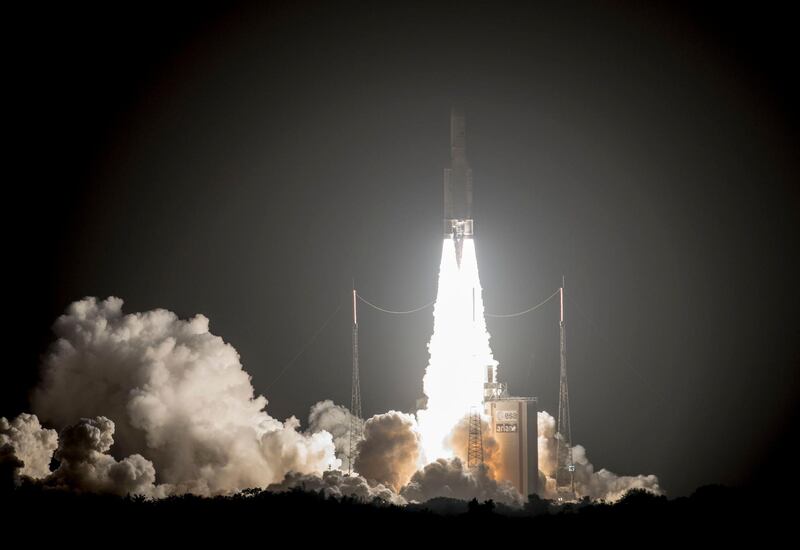The UAE’s newest satellite, Al Yah 3, is “healthy and operating normally” and has been “inserted into an orbit that differed from the flight plan”, Yahsat announced.
The Abu Dhabi satellite broadcasting company now says that “a revised flight plan will be executed to achieve the operational orbit and fulfil the original mission”.
While the satellite has reached the correct orbital altitude of about 45,000 kilometres, it is aligned at an angle far greater than is necessary for it to begin proper operations.
The problem is believed to have been caused by an unexpected deviation in the flight path of the Ariane 5 booster after its launch in the early hours of Friday morning.
Information released by the US Strategic Command Space Track website showed Al Yah 3 was at an orbital incline in relation to the equator of 21 degrees rather than the three degrees needed to function as planned.
Al Yah 3 is equipped with chemical rockets that can be used in short bursts to bring the satellite to the correct angle to the equator.
The fuel for the rockets is designed to allow for further corrections during the lifetime of the satellite and it is not clear if making these unanticipated changes so early will shorten its operational longevity.
Arianespace lost contact with its Ariane 5 booster nine minutes after the launch on Friday in French Guiana, although the Al Yah satellite and another for the European SES company were later confirmed to have separated from the rocket and to be working normally.
"Based on data from initial communications, I can report that Al Yah 3 is in orbit, healthy and responding to commands from our mission operations team," said Frank Culbertson, president of Orbital ATK's space systems group. "We will continue to work closely with our customer, Yahsat, to meet their mission objectives and remain confident that we will deliver a fully operational satellite to the planned orbit."
________________
Read more:
UAE's newest satellite will provide internet to remote global communities
Update: Al Yah 3 in orbit despite earlier lost contact
________________
Arianespace has since announced an independent inquiry headed by the general secretary of the European Space Agency.
The communications failure was a rare problem for the normally highly reliable Ariane 5 rocket, owned by a consortium of European companies.
The loss of contact after lift-off is believed to have been caused by the rocket deviating slightly from its planned flight path, meaning it missed key ground contact points.
Ariane officials briefly feared the rocket had failed but later confirmed both satellites had been released and were now in orbit, although not as originally planned.
Masood Mahmood,@yahsatofficial's CEO:Pleased to know that the satellite is healthy,&that the necessary steps are being taken to ensure the original mission is fulfilled.I would like to thank our technology partner Orbital ATK&Yahsat team in ensuring the #AlYah3 objectives are met pic.twitter.com/tdio4MAMEq
— Dubai Media Office (@DXBMediaOffice) January 26, 2018
Masood Mahmood, the chief executive of Yahsat, said in a post on Twitter, from Dubai Media Office, that he was “pleased to know that the satellite is healthy and that the necessary steps are being taken to ensure the original mission is fulfilled”.
Al Yah 3 was due to be released eight minutes after the SES-14 satellite and to begin initial operations early in the summer, expanding Yahsat’s services to 95 per cent of Brazil and 20 African countries,
Yahsat has not said if manoeuvring Al Yah 3 into its final position will delay these plans.
The SES-14 satellite uses slower electrical energy thrusters to reach orbit, with its operators saying the different release location means it will need an extra four weeks to get into position.
Al Yah 3 will join Al Yah 1 and Al Yah 2 in helping to empower millions of people across the Middle East, Africa, South West Asia and Brazil to access affordable Internet access via Yahsat’s high-speed satellite broadband service, YahClick. The service is designed to provide satellite broadband Internet to everyone, opening up new opportunities for every aspect of society from governments and enterprises to end users at home.
It will expand Yahsat’s commercial Ka-band coverage to an additional 19 new markets in Africa, reaching 60 per cent of the population. Furthermore, Al Yah 3 will serve Brazil, covering over 95 per cent of its population.
Al Yah 3 is due to begin delivering commercial services later in 2018.







